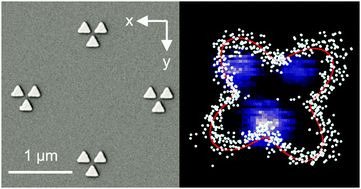Second harmonic generation from gold meta-molecules with three-fold symmetry
Abstract
The unique optical properties of arrays of metallic nanoparticles are of great interest for many applications such as in optical data storage, sensing applications, optoelectronic devices or as platforms to increase the detection limit in spectroscopic measurements. Nonlinear optical phenomena can also be altered by metallic nanostructures opening new possible applications. In this work, arrays composed of non-centrosymmetric individual structures with three fold axial symmetry made of gold are designed and fabricated using electron beam lithography. The nonlinear optical properties of these structures are investigated using second-harmonic generation microscopy (SHGM) with a femtosecond excitation source set near the plasmon resonance frequency. Modeling of the electromagnetic field distribution around the metallic structures is performed using the Finite Difference Time Domain (FDTD) method, highlighting the confinement of the SHG signal and its polarization dependence. Polarization-resolved measurements are conducted to correlate the SHG signal with the structure and symmetry of the individual nanostructures. Since both two-photon induced photoluminescence (TPPL) and SHG signals are produced upon excitation of these structures, lifetime measurements are performed to further evaluate the magnitude of these two effects.


 Please wait while we load your content...
Please wait while we load your content...